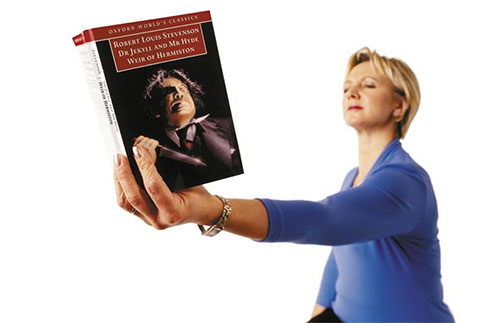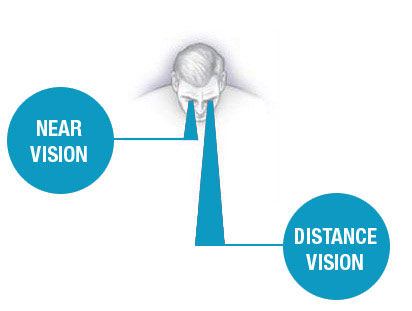Age-related farsightedness or presbyopia occurs after 40 years of age, and it is a sign of natural aging of the ocular lens and the consequent weakening of the accommodation of the eye. Accommodation is the ability of the eye to sharpen the image of objects close to us.
A person who has presbyopia most often notices this condition in situations when the hands become “too short”, i.e. he or she needs to move further away from the text they are reading. Correction of this farsightedness is done by adding “plus” lenses, starting at +0.75 diopters, already one-two years after the age of 40, and finally by the end of the age of 60 when the process of accommodation of the eye is generally completed. Then +2.50 to +3.0 diopters are added to make the person able to work and read up close, depending on the type of job he or she is doing.
By using laser eye surgery method called LASIK at the Polyclinic Bilić Vision we are able to give our patients the so-called monovision and in a large percentage to free them of age-related farsightedness, i.e. almost completely relieve the patients of wearing eyeglasses.
People older than 40 with age-related farsightedness, but also with nearsightedness, farsightedness or astigmatism and who want to discard their eyeglasses, are good candidates for laser eye surgery.

Candidates must be aware that the method is not permanent and that aging may result in natural clouding of the ocular lens - the so-called cataract, which could cause visual impairment.
Note:
At the Polyclinic Bilić Vision we have many years of experience in laser eye surgery. Our operators are surgeons with many years of experience and remarkable results.
It should be emphasized that monovision results are more permanent in nearsighted patients than in farsighted, due to easier recovery of plus diopter after surgery. This method represents a compromise, as it is possible to reach about 80-85% of your near vision, while in conditions of weaker light or the need to read tiny letters glasses will be required at lower percentage levels. At the Polyclinic Bilić Vision laser eye surgery is performed on an outpatient basis according to the principle of the so-called one-day surgery. This means that the patient does not need to lie down after the operation and that, after completion of the surgery, he or she is ready to go home.
The usual preoperative tests are not required except for examinations done at the Polyclinic since the procedure is performed under local anesthesia with the use of anesthetic drops. During surgery, the patient does not feel pain, but feels the physician touching the eye. The operation lasts between 10 and 15 minutes. The operation is completely painless and there are no stitches to close the wound.
Visual acuity determination is performed on a device that does computer calculation of vision, measures curvature and corneal thickness, and then it is subjectively checked how well the patient sees.
During the examination, a dominant and non-dominant eye is determined. Since, as a rule, the dominant eye is used to see in the distance, during laser nearsightedness correction non-dominant eye is left with a part of the diopter (up to -1.25) with the aim of making the remained minus annul the plus which progresses as we age, and thus good near vision is enabled.
This way, the dominant eye from which the diopter is completely removed, can see at a distance, and the non-dominant eye (with a small "minus" left) can see up close. By combining images in the brain that come from both eyes, the patient clearly sees at a distance (driving), at a medium distance (computer work) and up close (reading).
After determining the dominant eye, the patient has soft contact lenses inserted in both eyes in order to simulate the vision he or she will have after the laser eye surgery.

The following tests are the measurement of the eye pressure, the determination of the tear film stability, the pupil dilation, the examination of the ocular lens and the posterior eye segment, as well as re-measuring the diopter on the dilated pupil by the so-called skiascopy. Such a thorough examination takes about 1 hour.
Instructions before the operation:
There are no strict instructions on how to prepare for the operation, but we always advise you to:
Before the physician begins dripping the anesthetic into the patient’s eye, a part of the preoperative examination is repeated to confirm the accuracy of the measured diopter. Prior to surgery, the anesthetic is dripped into the patient’s eye. As the anesthetic begins to work, the surgery starts. The laser eye surgery lasts for only ten minutes on one eye and then the other eye is operated on. The procedure is painless and safe. First, with the help of the microkeratome, a small corneal flap is formed which is then slightly raised, enabling laser beams to smoothly model the cornea. Laser beams model the cornea and thus correct the vision. There is no danger that the laser will damage the eye in case the patient is restless because modern lasers such as the one at Polyclinic Bilić Vision have a safety system that stops the laser in case of eye shift or exit from the laser working area. The patient can hear the sounds and see different lights, but there is no pain during preparation nor operation itself. After the operation, it is necessary to lie down for about half an hour with the eyes closed so that the cornea flap is better fitted to its place. Then the patient goes home with drops of antibiotics and artificial tears as well as instructions (written and oral) about how to behave, use medicines, and check-ups. The patient can see quite well after the operation, but must be aware that day vision will be blurred. At the Polyclinic, the patient spends all together about 90 minutes.
The patient does not feel pain immediately after the operation nor later, but it is necessary to regularly take the given medications. Although the recovery after laser eye surgery to achieve mononvision is clinically fast - with an orderly flap healing and low probability of complications – a more pronounced eye dryness is possible as well as gradual adjustment of the eye to monovision over the first few weeks.
It is always necessary to see with both eyes and to practice both distance and near vision and not let yourself act on impulse and reach the reading glasses, since the eye gets quickly accustomed to the spectacles and then sees worse without them. As early as the next day, visual acuity returns to normal, and going back to work is possible 2-3 days after surgery. If the eye dryness is pronounced within the first 3-4 weeks, the visual acuity will seem worse as well. In agreement with the surgeon, the best ratio of artificial tears should be found in the form of droplets or gel, and in persistent cases, capsule suppositories and Omega 3 capsules or drops should be used. An antibiotic is dripped every three hours, and artificial tears every hour. Antibiotic drops are usually used only for one week, and artificial tears with a decrease in the frequency of drips up to six months. During the night it is not necessary to apply drops, however eye shields that protect the corneal flap from the mechanical shift should be used. The patient can watch television, work at a computer, but should not forget to regularly apply artificial tears, as looking at screens further dries the surface of the eye. This is not an operation after which it is necessary to lie down, but it is necessary to rest and avoid smoke-filled rooms or drafts. After 2 weeks make-up and exercise are allowed. No rough sports such as football, handball or anything similar are allowed, and saunas or swimming pools are not recommended for up to a month. After surgery, within the first 3-4 weeks, the patient will notice the recovery of vision, both in quality and quantity, on a daily basis. Check-ups are done on the first day, seventh day and a month after the operation. During each appointment, apart from the examination, detailed instructions will be given to the patient on how to behave in the further course of recovery.
Possible complications are rare and solvable. Eye dryness, irritation, micro lesions, diffusion of the light edges, and diopter reversion are actually side effects rather than true complications. All of them go slowly and spontaneously away or due to the use of medicines and surgical interventions. Nowhere in literature have the consequences of this procedure causing permanent reduction in visual acuity or blindness been described. The partial reversal of visual impairment usually occurs in cases of high nearsightedness or high farsightedness, but then the operation can be repeated, and in some situations where this is not possible - mainly due to too thin cornea - the lack of sufficient visual acuity is compensated by the use of prescription glasses. The diopter can be reversed within six months to a year, and sometimes earlier.
Become a part of the Polyclinic Bilić Vision family of satisfied patients and call today to be informed of the age-related laser eye surgery. You can make an appointment over the phone: +385 1 4678-444 or by email at info@bilicvision.hr.
Need more information? Can't find what you are looking for or want to make a doctor's appointment? Leave your information and we will contact you as soon as possible:
Vaš upit je zaprimljen! Hvala Vam na povjerenju!